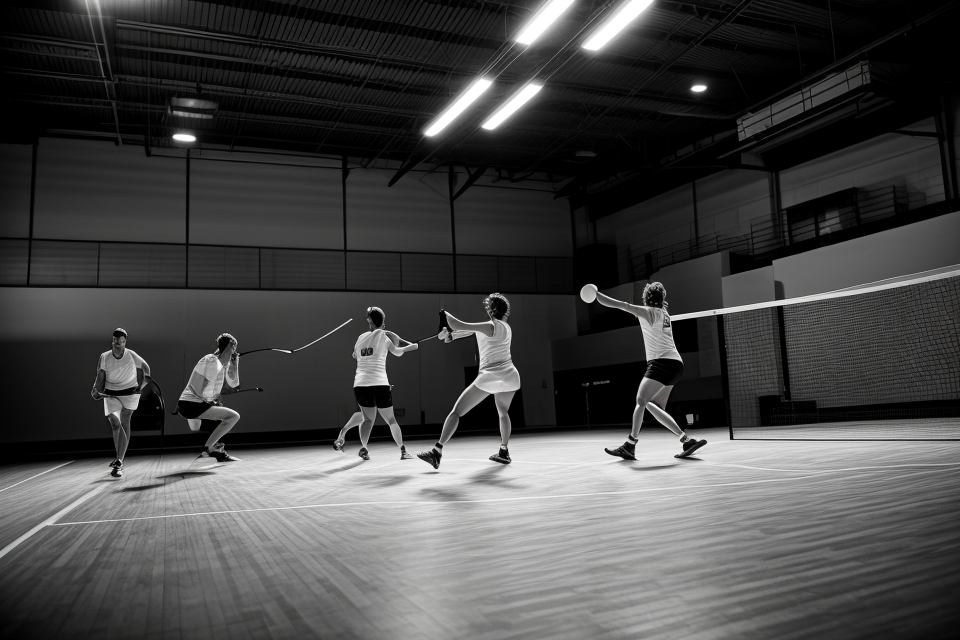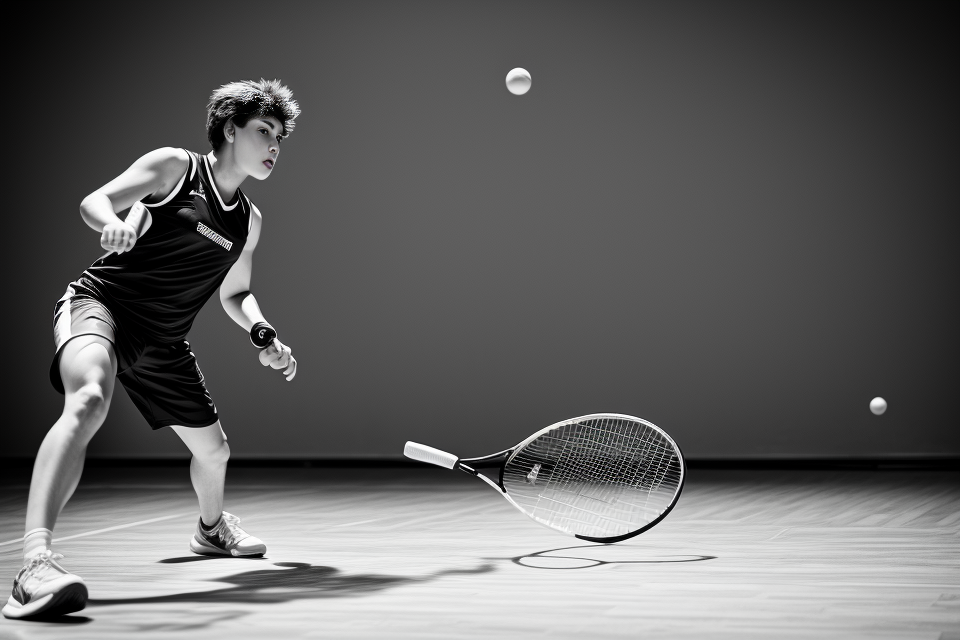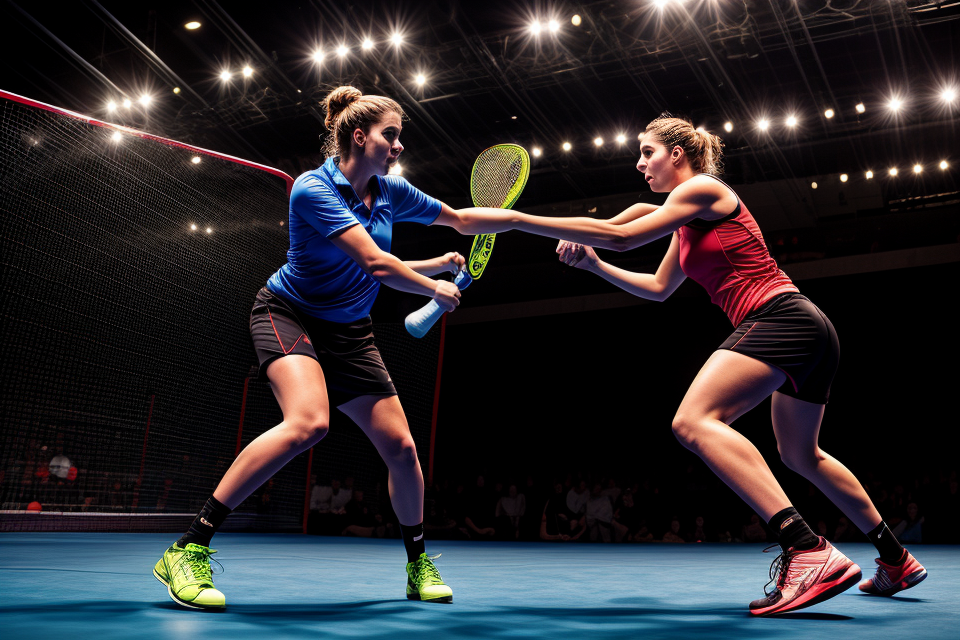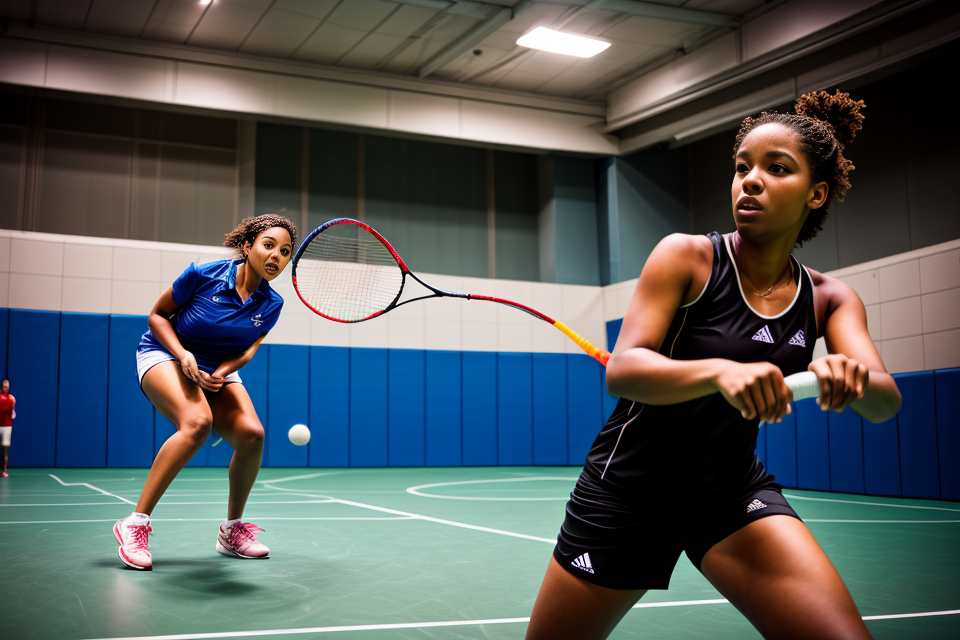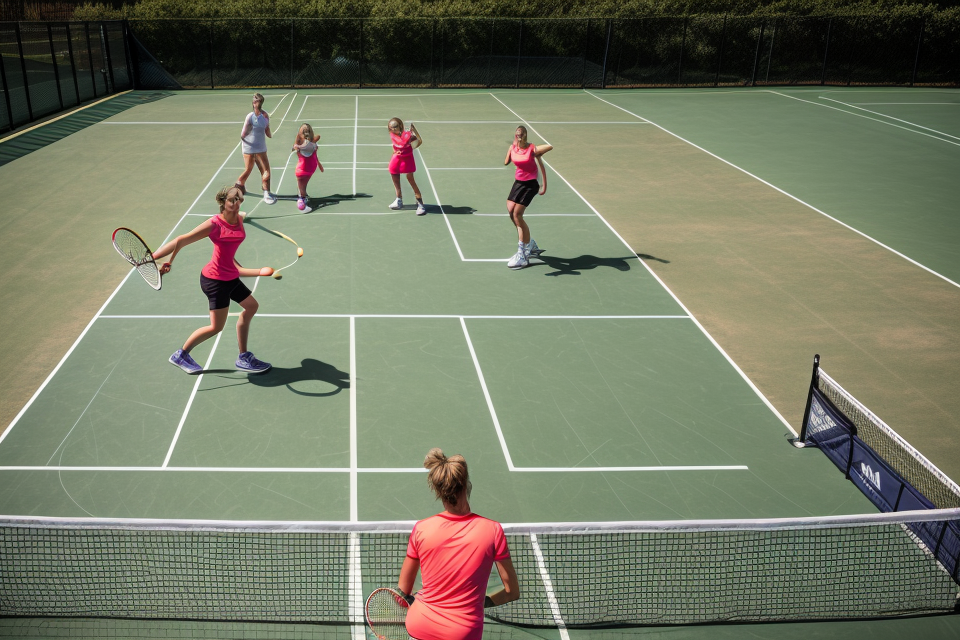Squash is a physically demanding sport that requires agility, strength, and endurance. As we age, our bodies undergo various changes that can affect our ability to perform at our best on the squash court. But at what age should you stop playing squash? In this guide, we’ll explore the factors that can influence your decision to hang up your squash racket and provide tips for players of all ages on how to make the most of their time on the court. Whether you’re a seasoned pro or a newcomer to the sport, this guide will help you determine when it’s time to retire your racket and focus on other activities. So, let’s dive in and explore the right time to stop playing squash.
Understanding the Risks of Playing Squash
Common Injuries in Squash
- Muscle strains:
- Squash is a fast-paced sport that requires quick movements and changes of direction, which can lead to muscle strains, particularly in the legs and lower back.
- Prolonged periods of play or training without adequate rest and recovery can increase the risk of muscle strains.
- Symptoms of muscle strains include pain, tenderness, and difficulty moving the affected muscle.
- Tendinitis:
- Tendinitis is an inflammation of the tendons, which connect muscles to bones.
- Squash players are at risk of developing tendinitis in the Achilles tendon, which connects the calf muscle to the heel bone, or in the patellar tendon, which connects the kneecap to the shinbone.
- Repetitive movements, such as jumping and running, can cause micro-tears in the tendons, leading to inflammation and pain.
- Rest, ice, compression, and elevation (RICE) can help reduce inflammation and alleviate symptoms of tendinitis.
- Cartilage damage:
- The cartilage in the knee and other joints can become damaged due to the high impact and stress placed on them during squash games.
- Cartilage damage can result in pain, swelling, and reduced mobility.
- Overuse injuries, such as playing on hard surfaces or excessive training, can increase the risk of cartilage damage.
- Treatment may involve rest, physical therapy, and medication, and in severe cases, surgery may be necessary.
- Concussions:
- Squash is a sport that involves physical contact and fast-paced movements, which can lead to collisions and head injuries.
- Concussions can occur when the head is hit against the wall or another player’s racket, or when falling to the ground.
- Symptoms of a concussion include headache, dizziness, confusion, and memory loss.
- It is important to seek medical attention if a concussion is suspected, and to follow a gradual return-to-play protocol to avoid further injury.
Age-Related Decline in Physical Abilities
As players age, their physical abilities naturally decline, which can increase the risk of injury while playing squash. Here are some of the specific ways in which age-related decline can affect a player’s performance:
- Reduced reaction time: As players age, their reaction time slows down, making it harder to react quickly to changing situations on the court. This can make it more difficult to hit the ball with precision and can increase the risk of missing the ball or making errors.
- Decreased eye-hand coordination: Eye-hand coordination is crucial in squash, as players need to be able to track the ball and hit it with accuracy. As players age, their eye-hand coordination may decline, making it harder to hit the ball with precision and increasing the risk of errors.
- Lower endurance levels: Squash is a physically demanding sport that requires players to be in good physical condition. As players age, their endurance levels may decline, making it harder to maintain a high level of physical activity for extended periods of time. This can make it more difficult to keep up with the pace of the game and can increase the risk of fatigue and injury.
- Greater risk of injury: As players age, their risk of injury increases due to the natural decline in physical abilities. This can be particularly problematic in a sport like squash, where players are constantly moving and jumping, and where the risk of collision with the wall or other players is always present. Injuries can range from minor strains and sprains to more serious injuries such as knee or back problems.
It’s important for players of all ages to be aware of these risks and to take steps to mitigate them. By staying in good physical condition, by taking the time to properly warm up and cool down before and after games, and by being mindful of their limitations, players can help to reduce their risk of injury and ensure that they can continue to enjoy the sport for years to come.
Assessing Your Squash Skills and Goals
Identifying Your Strengths and Weaknesses
- Physical abilities
- Agility and footwork
- Endurance and stamina
- Eye-hand coordination
- Strength and power
- Technical skills
- Shot selection and execution
- Racket control and precision
- Movement and positioning
- Serving and returning
- Tactical knowledge
- Understanding of court geometry
- Knowledge of opponent’s weaknesses
- Strategic decision-making
- Adaptability to changing situations
- Mental toughness
- Resilience and perseverance
- Focus and concentration
- Positive attitude and self-belief
- Dealing with pressure and adversity
As a squash player, it is important to identify your strengths and weaknesses in order to determine your overall level of play and potential for improvement. This self-assessment can help you set realistic goals and develop a plan for continued growth and development as a player.
When evaluating your physical abilities, consider your agility and footwork, endurance and stamina, eye-hand coordination, and strength and power. These factors can all contribute to your overall effectiveness on the court and your ability to perform at a high level.
Your technical skills, including shot selection and execution, racket control and precision, movement and positioning, and serving and returning, are also important factors to consider. By assessing your proficiency in these areas, you can identify areas for improvement and focus your training efforts on developing your technical abilities.
In addition to technical skills, tactical knowledge is crucial for success in squash. Consider your understanding of court geometry, knowledge of opponent’s weaknesses, strategic decision-making, and adaptability to changing situations. By evaluating your tactical skills, you can develop a more comprehensive understanding of your overall game and make informed decisions about how to improve.
Finally, mental toughness is a key factor in squash success. Evaluate your resilience and perseverance, focus and concentration, positive attitude and self-belief, and ability to deal with pressure and adversity. By developing mental toughness, you can become a more competitive and successful player.
Setting Realistic Goals
Setting realistic goals is a crucial step in determining when it is time to hang up your squash racket. Whether you are a beginner or an experienced player, setting achievable objectives can help you enjoy the game and progress at a comfortable pace. Here are some tips for setting realistic goals:
Short-term goals
Short-term goals are objectives that you aim to achieve within a few weeks or months. These goals should be specific, measurable, attainable, relevant, and time-bound (SMART). For example, if you are a beginner, a short-term goal could be to learn how to hit a straight shot. If you are an intermediate player, a short-term goal could be to improve your footwork and movement on the court.
Long-term goals
Long-term goals are objectives that you aim to achieve within a year or more. These goals should also be SMART. For example, if you are a beginner, a long-term goal could be to compete in a local tournament. If you are an advanced player, a long-term goal could be to qualify for a national championship.
Personal goals
Personal goals are objectives that are important to you personally, but may not necessarily relate to your squash skills. For example, a personal goal could be to make new friends or to improve your overall fitness level. Incorporating personal goals into your squash routine can help you stay motivated and enjoy the game even more.
Competitive goals
Competitive goals are objectives that relate to your performance in tournaments or matches. These goals should be challenging but achievable, and should take into account your current skill level and physical condition. For example, if you are a beginner, a competitive goal could be to win a single match in a local tournament. If you are an advanced player, a competitive goal could be to reach the top 10 in your age group.
Overall, setting realistic goals can help you stay focused and motivated, and can ensure that you continue to enjoy squash for years to come.
Developing a Squash Retirement Plan
Gradual Reduction of Playing Time
As a player approaches the end of their squash career, it’s important to develop a plan for retiring from the sport gradually. One way to do this is by gradually reducing the amount of time spent playing squash. Here are some tips for reducing playing time in a way that is both safe and effective:
- Starting with one less game per week: One way to start reducing playing time is by gradually decreasing the number of games played per week. For example, if a player typically plays three games per week, they could start by reducing their playing time to two games per week, and then gradually reduce their playing time further until they are only playing one game per week.
- Gradually reducing matches: Another way to reduce playing time is by gradually reducing the number of matches played per week. For example, a player who typically plays three matches per week could start by reducing their playing time to two matches per week, and then gradually reduce their playing time further until they are only playing one match per week.
- Incorporating other physical activities: As a player reduces their playing time, it’s important to incorporate other physical activities into their routine to stay active and maintain their overall health. This could include activities such as swimming, cycling, or even yoga. These activities can help a player maintain their physical fitness while reducing their risk of injury.
By gradually reducing playing time in a way that is both safe and effective, players can make the transition from competitive squash to a more relaxed, recreational form of the sport. This can help them stay active and engaged in the sport they love, while also protecting their health and well-being.
Exploring Alternative Ways to Stay Involved
As players reach the end of their competitive squash careers, it can be difficult to let go of a sport that has been a significant part of their lives. However, there are many ways to stay involved in the sport and give back to the squash community.
Coaching or mentoring younger players
One way to stay involved in squash after retiring from competitive play is to coach or mentor younger players. This can be a rewarding experience for both the coach and the player, as it allows the coach to pass on their knowledge and experience to the next generation of squash players. It can also help the retired player stay connected to the sport and feel like they are still contributing to its growth and development.
To become a coach or mentor, players can seek out local squash clubs or organizations that offer coaching programs or mentorship opportunities. They can also reach out to schools or community centers that have squash courts and offer to coach or mentor young players. In addition, players can consider getting certified through a squash coaching organization, such as the United States Squash Association or the Professional Squash Association, to increase their credibility and expertise.
Volunteering at tournaments
Another way to stay involved in squash after retiring from competitive play is to volunteer at tournaments. This can be a great way to give back to the sport and stay connected to the squash community. Volunteering at tournaments can involve a variety of tasks, such as assisting with registration, manning a scoreboard, or helping with court setup and teardown.
To volunteer at tournaments, players can reach out to local squash clubs or organizations that host tournaments and offer their services. They can also sign up for volunteer opportunities through the tournament’s website or through a squash coaching organization. Volunteering at tournaments can be a fun and rewarding way to stay involved in the sport and support the growth and development of the squash community.
Joining a squash club’s committee
Finally, another way to stay involved in squash after retiring from competitive play is to join a squash club’s committee. This can be a great way to give back to the sport and help support the growth and development of the squash community. Joining a squash club’s committee can involve a variety of tasks, such as organizing events, managing finances, or promoting the club to new members.
To join a squash club’s committee, players can reach out to their local squash club or organization and offer their services. They can also attend club meetings and get involved in committee discussions and decision-making processes. Joining a squash club’s committee can be a rewarding way to stay involved in the sport and support the growth and development of the squash community.
Staying Active and Maintaining Fitness
Maintaining physical fitness is essential for individuals who wish to retire from squash. Here are some activities that can help players stay active and maintain their fitness levels:
- Swimming: Swimming is a low-impact exercise that is gentle on the joints and provides an excellent full-body workout. It is an excellent way to improve cardiovascular fitness, build muscle strength, and improve flexibility. Swimming can also help with weight loss and stress relief.
- Cycling: Cycling is another low-impact exercise that is great for cardiovascular fitness. It is also a low-impact exercise that is gentle on the joints and provides an excellent full-body workout. Cycling can help build muscle strength, improve cardiovascular fitness, and reduce stress.
- Weightlifting: Weightlifting is an excellent way to build muscle strength and improve overall fitness. It is important to consult with a fitness professional before starting a weightlifting routine to ensure that the exercises are safe and effective.
- Yoga: Yoga is a mind-body practice that can help improve flexibility, balance, and stress relief. It is an excellent way to improve overall fitness and mental well-being.
Overall, it is important to find activities that are enjoyable and sustainable for maintaining physical fitness. Consulting with a fitness professional can help individuals develop a personalized fitness plan that is tailored to their individual needs and goals.
Making the Decision to Stop Playing Squash
Listening to Your Body
When it comes to deciding when to stop playing squash, listening to your body is essential. It’s crucial to pay attention to any pain or discomfort you may be experiencing, as ignoring these signals can lead to more serious injuries. Here are some specific signs to look out for:
- Pain or discomfort that persists even after you’ve rested or taken medication
- A sharp or intense pain that feels different from your usual muscle soreness
- Swelling, redness, or warmth in a particular area of your body
It’s also important to recognize the signs of overtraining, which can include fatigue, a lack of motivation, and a decrease in performance. If you find that you’re struggling to keep up with your training or that you’re no longer enjoying the sport, it may be time to take a break.
Finally, it’s crucial to understand the need for rest and recovery. Your body needs time to repair and rebuild itself after a workout, and if you don’t give it enough rest, you may be at risk for overuse injuries. Make sure to incorporate rest days into your training schedule and listen to your body’s needs.
Balancing Personal and Professional Obligations
- Family and social commitments
- As a player, it is important to prioritize family and social commitments. This means taking into account the needs and schedules of your loved ones when making decisions about your squash playing career. For example, if you have young children, you may need to take into account their extracurricular activities and school schedules when deciding whether or not to attend a tournament or practice session.
- Work and career demands
- Similarly, work and career demands can also play a significant role in determining when the right time to hang up your squash racket may be. If you have a demanding job or career that requires a lot of your time and energy, you may need to reevaluate your priorities and determine whether or not squash is still a feasible and enjoyable activity for you.
- Other interests and hobbies
- In addition to family and work obligations, other interests and hobbies can also factor into the decision to stop playing squash. If you have other passions or activities that you enjoy, it may be worth considering whether or not squash is still the best use of your time and energy. For example, if you have always been interested in painting, but have never had the time to pursue it, you may want to consider taking a break from squash to explore this new hobby.
Seeking Support from Others
When considering the right time to stop playing squash, seeking support from others can be an essential aspect of the decision-making process.
Squash coaches
Squash coaches can provide valuable insights and guidance for players contemplating retirement from the sport. They have experience working with players of all ages and skill levels, and can offer an objective perspective on a player’s abilities and potential areas for improvement. A coach can also help a player identify whether their current level of play is declining, and if so, how much. Additionally, a coach can provide advice on alternative activities or sports that may be suitable for a player as they transition away from squash.
Sports medicine professionals
Sports medicine professionals, such as sports medicine doctors or physical therapists, can provide valuable information about the physical impact of playing squash and the potential risks associated with continuing to play. They can assess a player’s physical condition and provide recommendations on whether it is safe for them to continue playing at their current level or if they should consider reducing their playing time. They can also advise on the best ways to prevent injuries and maintain physical fitness as a player transitions away from squash.
Fellow players and friends
Fellow players and friends can also play an important role in helping a player decide when to stop playing squash. They can provide insight into the player’s current level of play and offer advice on whether they believe the player is still competitive. They can also provide emotional support during the decision-making process and offer encouragement to continue playing or to retire from the sport. It is important to remember that everyone’s experiences and perspectives are different, and it is essential to consider a range of opinions before making a final decision.
Moving On with Grace and Dignity
As you contemplate hanging up your squash racket, it’s important to do so with grace and dignity. Here are some steps you can take to ensure a smooth transition out of the sport:
Reflecting on your squash journey
Take some time to reflect on your squash journey. Think about how you got started in the sport, the memories you’ve made, and the skills you’ve developed. Consider the highs and lows, the challenges you’ve faced, and the lessons you’ve learned. Reflecting on your journey can help you appreciate the impact that squash has had on your life and give you a sense of closure as you move on.
Expressing gratitude for the experiences and memories
As you reflect on your squash journey, take time to express gratitude for the experiences and memories you’ve made. Whether it’s the friendships you’ve formed, the opponents you’ve faced, or the victories you’ve celebrated, take the time to express your appreciation for the sport and the impact it’s had on your life. This can help you transition out of the sport with a positive attitude and a sense of fulfillment.
Celebrating your achievements and contributions to the sport
Finally, celebrate your achievements and contributions to the sport. Whether you’re a seasoned pro or a recreational player, you’ve likely accomplished many things in your squash career. Take the time to celebrate these achievements and recognize the contributions you’ve made to the sport. This can help you feel a sense of pride and accomplishment as you move on from the sport.
By reflecting on your squash journey, expressing gratitude for the experiences and memories, and celebrating your achievements and contributions to the sport, you can move on from squash with grace and dignity.
FAQs
1. At what age should you stop playing squash?
There is no definitive age at which you should stop playing squash. Many players continue to enjoy the sport well into their 50s, 60s, and even 70s. However, it is important to listen to your body and pay attention to any physical limitations or injuries that may affect your ability to play the sport safely.
2. Can playing squash cause injury?
Like any physical activity, squash can potentially cause injury if proper precautions are not taken. However, with proper technique, equipment, and warm-up exercises, the risk of injury can be minimized. It is important to seek medical advice if you experience any pain or discomfort while playing squash.
3. Is it possible to continue playing squash into old age?
Yes, it is possible to continue playing squash into old age. Many players find that squash is a great way to stay active and healthy as they age. However, it is important to gradually modify your training and playing schedule as you get older to accommodate any physical changes and to prevent injury.
4. What are the benefits of playing squash?
Squash is a great way to stay active and healthy, as it provides a full-body workout that can improve cardiovascular fitness, strength, and flexibility. It also helps to improve hand-eye coordination and reaction time, and can be a fun and social way to stay active.
5. How can I improve my squash skills?
Improving your squash skills requires a combination of physical conditioning, technical practice, and match play. It is important to incorporate a mix of cardiovascular exercises, strength training, and flexibility exercises into your training routine. You can also work with a coach or join a squash club to get more match play experience and receive feedback on your technique.






